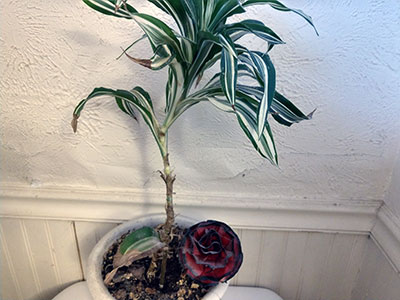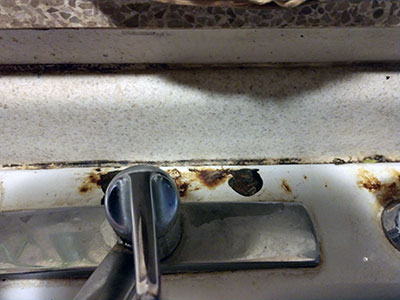By Elizabeth Zach, RCAC staff writer
In February, Daphne Rotolo received some distressing news from a woman she was helping to find better housing. As a homeownership assistant with Housing Resources of Western Colorado, she’s seen and heard about many troublesome living situations. This was among the worst.

Lee Ann Waychoff, who was renting a house in Conifer, in Jefferson County, Colorado wrote to Rotolo. In her email, Waychoff included photos of bubbled paint, water leaking through electrical lamps, the kitchen sink rotting through the countertop, a floor sinking because of a faulty seal in the toilet, a window sill where rain was pouring in, and water leaking through a main support ceiling beam.
“Mold, leaking faucets, rotting floor around the toilet, light fixtures that have water leaking through them,” Waychoff wrote. “And did I mention black mold? And that my boyfriend is on oxygen?”
“The roofers who finally got the job done properly said the roof was only about the thickness of a piece of paper,” Waychoff wrote. “This was after four years of us living here.”

“I was shocked that the landlord raised their rent so he could fix the living conditions, which should have been fixed before anyone lived in the house,” she said, adding that Waychoff is dependent on Social Security Disability Insurance, Supplemental Security Income and Veterans Affairs benefits from her previous spouse. Her adjusted annual income is $35,010, which is considered low for Jefferson County.
Eventually, Rotolo counseled Waychoff to apply for a 502 Direct Loan, which would help her and her boyfriend purchase an affordable home. Waychoff followed through and in July, picked up the keys to their new abode in Park County.
Traditional mortgage financing and homeownership are often out of reach for low- and very low-income rural residents. For this reason, the U.S. Department of Agriculture Rural Development (USDA RD) designed its Single Family Direct Loan Program, commonly called 502 direct loans, as an affordable alternative.
In short, the loan subsidizes a mortgage for a modest home in a rural area. The applicants are usually first-time homebuyers in areas with a population of 35,000 or less. The funds can be used to build, repair, renovate or relocate a home, or to purchase and prepare sites, including building or improving water and sewage facilities. USDA Mutual Self-Help Housing Program participants often use 502 direct loans. The guiding idea behind the program is that homeownership contributes to overall prosperity in communities.
RCAC is an intermediary and quality assurance reviewer for these packaged loan applications. This means that RCAC trains loan officers to process these unique loans, and also reviews completed loan applications for accuracy and completeness before sending them to USDA RD for approval. The program has been so successful that in 2016, USDA made the program permanent. Angela Sisco is among RCAC’s trainers.
“There are only three organizations in the country that offer this training, and RCAC is one of them,” said Sisco, a Rural Development Specialist serving Alaska, Colorado, Idaho and Utah. “It can be time-consuming but I find the day-to-day work with self-help grantees really rewarding, to be able to give them this knowledge and explain the resource. Over the years it’s turned into a much bigger body of work.”
In 2017, RCAC staff reviewed 99 applications and helped 47 families to secure these home loans, which represents $9,717,637 in mortgage funds to rural families.
“If they can build a home that used local labor and supplies and insurance, water and electricity supplied locally, they’re creating a tax base and income with a product from the government,” said Tom Carew, executive vice president of Membership and Advocacy for the Federation of Appalachian Housing Enterprises (FAHE), which collaborated with Rural Community Assistance Corporation (RCAC) in 2009 to establish the 502 packaging program across its rural West footprint.
The idea was to assist and expand the program at a time when USDA staff could not keep up with the demand to review and approve applications in rural America.
“This isn’t a bridge to nowhere,” Carew said. “It’s a bridge to home ownership, a product that actually does something.”
Although RCAC offers this program in every state it operates, Colorado was early to begin offering these loans and during the past several years, has processed many of them. In Colorado, RCAC staff work with seven qualified employers: Blue Spruce Habitat for Humanity; Community Resources and Housing Development Corporation; Habitat for Humanity of Roaring Fork Valley; Housing Resources of Western Colorado; Northeast Colorado Housing Inc.; Tri County Housing CDC Inc.; and the Upper Arkansas Area Council of Governments.
According to Bernice Williams, Single Family Housing Specialist for the USDA RD office in Denver, the state has approved 46 packaged loans for a total of $8,292,185 so far this fiscal year, compared to 29 packaged loans last fiscal year.
“Packaged loans currently equate to about 43 percent of our loan volume,” Williams said. “This is a substantial increase from last year and indicates that our packaging program is working well.”
“Bernice embraced packaging as a program,” said Scott Wilson, director for single family housing programs in the same office. “Before I arrived three years ago, she was already encouraging our staff to give packaging a try, and she also convinced several of the nonprofit housing officers to become packagers. I strongly encouraged my team, too. All of this helps us offer more loans.” As RCAC staff has provided training and support to nonprofit housing organizations that want to become 502 loan packagers, the processing and closing time has decreased during the years, allowing more rural families to afford decent homes.
“(Rural families) don’t have the same access to housing credit as you do in urban centers,” Carew said. “It’s a combination of affordable financing, an affordable way of building homes, just being able to get that money where it needs to be.”
The program offers families payment assistance in the way of a subsidy that reduces the mortgage payment for a short time. The amount of assistance depends on the family’s income, which must be at or below the applicable low-income limit for the area where they wish to buy a house. They must also repay all or a portion of the subsidy during the life of the loan, when the title to the property transfers, or they leave the dwelling, in which case they would be obligated to pay back the subsidy.
Above all, however, the program aims to help the neediest families, those without decent and safe housing. These families have tried to get loans elsewhere but didn’t qualify, for whatever reason, although they had the legal capacity to take on the loan obligation. A 502 loan can have an interest rate as low as 1 percent, for terms between 33 and 38 years.
As for Colorado, Rotolo is committed to helping more would-be homeowners like Lee Ann Waychoff.
“It was an exciting process,” said Waychoff, “and now my dream is coming true.”
